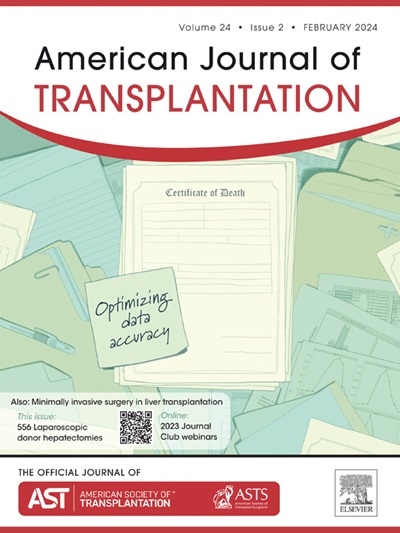体外扩增toll样受体- bregs上的PD-L1通过促进Breg活力、抑制CD4+T效应细胞和诱导Tregs来预防同种异体移植排斥。
IF 8.2
2区 医学
Q1 SURGERY
引用次数: 0
摘要
实现免疫耐受是器官移植的关键目标,因为它消除了长期免疫抑制的需要。调节性B细胞(Bregs)是诱导耐受性的一种很有前途的策略。我们之前的研究结果表明,过继移植体外扩增的小鼠脾B调节细胞,即TLR-Bregs (TLR9/TLR4刺激),可诱导对同种异体移植物的耐受。在这里,我们发现循环T细胞在TLR-Bregs细胞治疗后增加了PD-1的表达。为了研究PD-L1-PD-1信号是否参与TLR-Bregs诱导耐受性,我们从野生型(WT)或pd - l1缺陷(-/-,KO) B6脾细胞中产生TLR-Bregs,并评估其调节功能。我们的研究结果表明,TLR-Bregs表达高水平的PD-L1,并通过PD-L1依赖机制延长移植物存活。在机制上,PD-L1增强TLR-Bregs的激活和存活;TLR-Bregs需要PD-L1来诱导PD-1表达和对效应CD4+T细胞的最佳抑制,同时促进功能性Foxp3hiCCR7hiCTLA4hiTregs的形成。本研究强调了PD-L1在体外扩增TLR-Bregs诱导耐受中的基础作用。本文章由计算机程序翻译,如有差异,请以英文原文为准。
PD-L1 on ex-vivo Expanded Toll-like-receptor-Bregs Prevents Allograft Rejection by Breg Viability Promotion, CD4+T Effector Cell Suppression, and Tregs Induction.
Achieving immune tolerance is a key goal in organ transplantation, as it eliminates the need for long-term immunosuppression. Regulatory B cells (Bregs) present a promising strategy for inducing tolerance. Our previous findings demonstrate that the adoptive transfer of ex vivo-expanded murine splenic B regulatory cells, referred to as TLR-Bregs (TLR9/TLR4 stimulation), induces tolerance to allografts. Here, we identify that circulating T cells increase PD-1 expression following TLR-Bregs cellular therapy. To investigate whether PD-L1-PD-1 signaling is involved in tolerance induction by TLR-Bregs, we generate TLR-Bregs from wild-type (WT) or PD-L1-deficient (-/-, KO) B6 splenocytes and assess their regulatory functions. Our findings reveal that TLR-Bregs express high levels of PD-L1 and extend graft survival via a PD-L1-dependent mechanism. Mechanistically, PD-L1 enhances the activation and survival of TLR-Bregs; PD-L1 is required for TLR-Bregs to induce PD-1 expression and an optimal inhibition of effector CD4+T cells while promoting the formation of functional Foxp3hiCCR7hiCTLA4hiTregs. This study highlights the foundational role of PD-L1 in inducing tolerance by ex-vivo-expanded TLR-Bregs.
求助全文
通过发布文献求助,成功后即可免费获取论文全文。
去求助
来源期刊
CiteScore
18.70
自引率
4.50%
发文量
346
审稿时长
26 days
期刊介绍:
The American Journal of Transplantation is a leading journal in the field of transplantation. It serves as a forum for debate and reassessment, an agent of change, and a major platform for promoting understanding, improving results, and advancing science. Published monthly, it provides an essential resource for researchers and clinicians worldwide.
The journal publishes original articles, case reports, invited reviews, letters to the editor, critical reviews, news features, consensus documents, and guidelines over 12 issues a year. It covers all major subject areas in transplantation, including thoracic (heart, lung), abdominal (kidney, liver, pancreas, islets), tissue and stem cell transplantation, organ and tissue donation and preservation, tissue injury, repair, inflammation, and aging, histocompatibility, drugs and pharmacology, graft survival, and prevention of graft dysfunction and failure. It also explores ethical and social issues in the field.

 求助内容:
求助内容: 应助结果提醒方式:
应助结果提醒方式:


